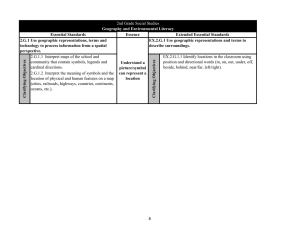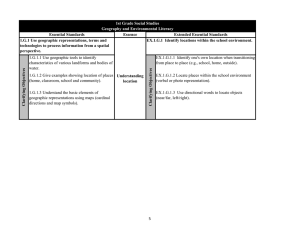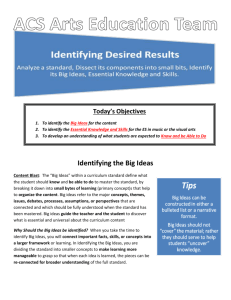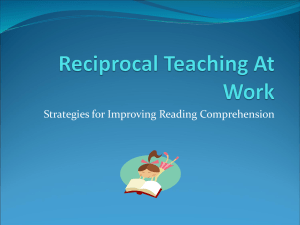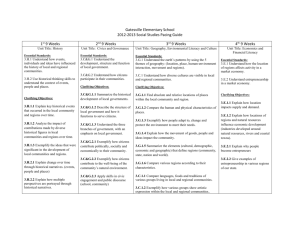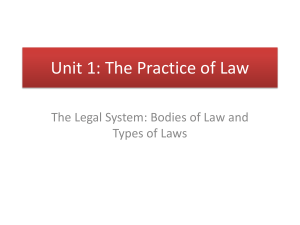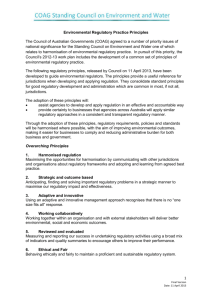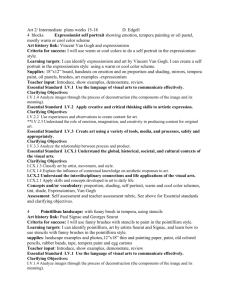Science Essential Standards
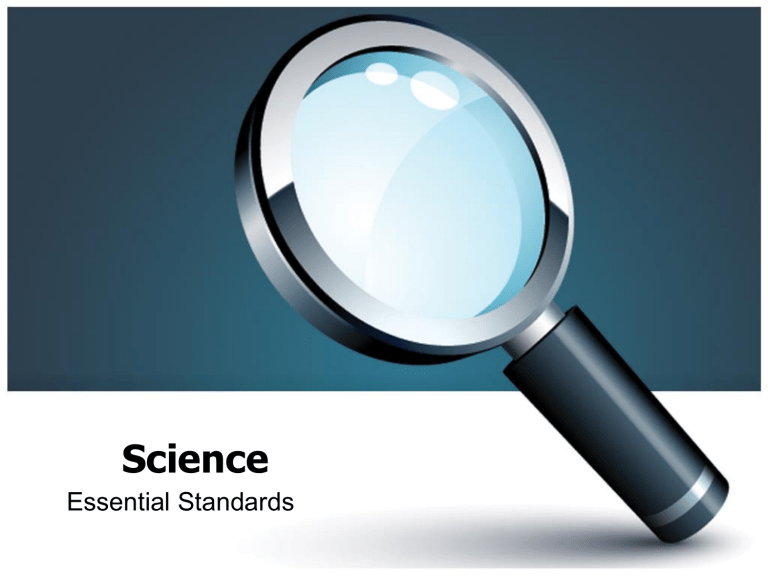
Science
Essential Standards
Not Common Core
•New Essential Standards are based on
National Science Benchmarks
•More closely aligned with other states
Compare the Average Grade 4 NAEP Score in 2009 to Other
States/Jurisdictions
In 2009, the average score in North Carolina was lower than those in 24 states/jurisdictions higher than those in 9 states/jurisdictions not significantly different from those in 13 states/jurisdictions
5 states/jurisdictions did not participate
Revised Bloom’s Taxonomy (RBT)
Three Domains
• Physical Science
• Earth Science
• Life Science
Physical Science
Forces and Motion
Matter:
Properties of
Change
Energy :
Conservation and
Transfer
Earth Science
Systems, Structures
Processes Earth History
Life Science
Structures and
Functions of
Living Organisms
Ecosystems
Evolution
And
Genetics
Molecular Biology
Science as Inquiry: K-2
• Hands-On AND Minds-On
• Experimentation and Technological Design
• Purposeful exploration
• Should use tools such as: magnifiers, thermometers, rulers, or balances to gather data and extend senses
• Should be encouraged to employ oral language, drawings, and models to communicate results and explanations of investigations and experiments in a cooperative learning environment
K-2 Inquiry
• Provide time to discuss observations
• Encourage new observations rather than debates about who is correct
Science as Inquiry: 3-5
• Students should be encouraged to make careful observations
• Measure with increasing accuracy
• Use more advanced tools such as calculators, computers, graduated cylinders, scales, and meter sticks to gather data and extend senses
• Must keep accurate records and run enough trials to be confident of results to test a prediction
• Employ more sophisticated language, drawings, models, charts and graphs to communicate results and explanations
3-5 Inquiry
• Use patterns in data to create explanations of results
• Require record-keeping and multiple tests to verify prediction results
Stair Step Curriculum
Motion and Design
PHYSICAL SCIENCE: Forces and Motion
Kindergarten Essential Standard Clarifying Objective
K.P.1.
K.P. 2.
Understand the positions and motions of objects and organisms observed in the environment
Understand how objects are described based on their physical properties and how they are used.
K.P.1.1. Relative position: In front of, behind, between, etc.
K.P.1.2. Move: straight, zigzag, round
K.P.2.1. size, color, shape, texture
K.P.2.2. different materials clay, wood, cloth,
First Grade
Physical Science: Forces and Motion
Essential Standard Clarifying Objective
1.P.1
Understand how forces (pushes and pulls) affect the motion of an object
1.P.1.1 Explain the importance of a push or a pull to changing motion
1.P.1.2. Explain how some forces can be used to make things move without touching them
(magnets)
1.P.1.3. Balanced forces
Physical Science: Forces and Motion
Second Grade Essential Standard Clarifying Objective
2.P.1. Understand the relationship between sound and vibrating objects
2.P.1.1. Illustrate how sound is produced by vibrating objects and columns of air
2.P.1.2. Summarize the relationship between sound and objects of the body that vibrate.
Third Grade Essential Standard Clarifying Objective
3.P.1 Understand motion and factors that affect motion
3.P.1.1. Infer changes in speed or direction resulting from forces acting upon an object
3.P.1.2. Compare the relative speeds of objects that travel the same distance in different amounts of time
3.P.1.3. Explain the effects of Earth’s gravity on objects on
Earth.
Fourth Grade Essential Standards Clarifying Objectives
4.P.1. Explain how various forces affect the motion of an object.
4.P.1.1. Explain how magnets interact with all things iron and with other magnets to produce motion without touching them
4.P.1.2. Explain how electrically charged objects push or pull on other electrically charged objects.
Fifth Grade Essential Standard Clarifying Objective
5.P.1 Understand force, motion, and the relationship between them.
5.P.1.1. Explain how factors such as gravity, friction, and change in mass affect motion.
5.P.1.2. Infer the motion of objects in terms of how far they travel in a certain amount of time.
5.P.1. 3. Illustrate the motion of an object using a graph to show a change in position over a period of time.
5.P.1.4. Predict the change in force or a change in mass on the motion of an object.
Word Walls
• Students need to use the language of science
• Need to practice new language with peers
• Highlight features, forms of the word, homophones (cell)
Resources
• Unpacking Documents : http://www.dpi.state.nc.us/docs/acre/standards/supporttools/unpacking/science/2.pdf
• Crosswalks: http://www.dpi.state.nc.us/docs/acre/standards/supporttools/crosswalks/science/grade4.pdf
• www.project2061.org
• http://scnces.ncdpi.wikispaces.net/WEBINAR+SERIES+2011+-+2012
• http://scnces.ncdpi.wikispaces.net/file/view/Force+and+Motion+grade+5.
docx
• http://dpi.state.nc.us/docs/acre/assessment/science.doc
Jeopardy Review
• http://jeopardylabs.com/play/science-nc-essential-standards
